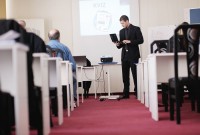- Home
- Business Processes
- Industry Knowledge
- Aerospace Industry
- Automotive Industry
- Banking Domain
- BFSI Industry
- Consumer/ FMCG Industry
- Chemicals Industry
- Engineering & Construction
- Energy Industry
- Education Domain
- Finance Domain
- Hospitality Domain
- Healthcare Industry
- Insurance Domain
- Retail Industry
- Travel and Tourism Domain
- Telecom Industry
- Leadership Skills
- eLearning
- Home
- Leadership Skills
- Leadership Theories
- Cognitive Resource Theory
Cognitive Resource Theory
The cognitive resource theory states the influence of the leader's resources on his or her reaction to stress. The cognitive resources of a leader are experience, intelligence, competence, and task-relevant knowledge. Stress is common in resource managing situations, and this cognitive theory emphasizes how intelligence and experience are each best under different stress situations. This theory is the reconceptualization of the Fiedler model.
In the early 1990s, the original model of Fiedler was re-conceptualized by Fiedler and his associate Joe Garcia, as Cognitive Resource Theory. In this model, the focus has been laid on the role of stress as a form of situational un-favorableness and how a leader’s intelligence and experience influence her/his reaction to stress.
What is meant by cognition?
Cognition is the mental action or process of acquiring knowledge and understanding through thought, experience, and the senses. Good examples of cognition are learning and our ability to reason through logic. Cognitive processes use existing knowledge and generate new knowledge. Cognitive processes are analyzed from different perspectives within different contexts like psychiatry, psychology, education, philosophy, and computer science.
Cognitive Resource Theory of Leadership
The Contingency Model developed by Fiedler was criticized for its lack of flexibility and also over the accuracy of the LPC scale. Fiedler then went on to develop the Cognitive Resource Theory (CRT) which takes into account the personality of the leader, degree of situational stress, and group-leader relations.
The assumption behind this theory is that stress impacts the ability to make decisions. It is the enemy of rationality and a leader cannot think in a logical and analytical manner if she/he is under a high level of stress. According to this proposition, the importance of a leader’s intelligence and experience to effectiveness differs under low and high-stress situations.
Fiedler and Gracia state that a leader’s intellectual ability correlates positively with performance under low stress but negatively under high stress. And conversely, a leader’s experience correlates negatively with performance under low stress but positively under high stress.
Thus, according to Fiedler and Gracia, the level of stress in a situation, determines whether an individual’s intelligence or experience will contribute to leadership performance.
Predictions of Cognitive Resource Theory
The Cognitive Resource theory predicts that the leader's abilities and intelligence can aid organizational success only when leaders adopt a directive leadership style, the situation is stress-free, the group members are supportive and the task requires high intellect. These attributes are discussed below:
1. Directive Approach
When a leader is better in cognitive abilities like intelligence, planning, and decision-making, he must follow a directive approach to improve the overall performance of the team. He needs to communicate to the group what to do, to ensure his plans and decisions are implemented, hence improving the overall performance of the group.
When the group and the people on the group are better than the leader in cognitive abilities, then the leader should choose a non-directive approach. He should seek ideas from the group and identify the best approach/idea and move ahead with the same.
A leader's cognitive ability contributes to the performance of the team only when the leader uses the directive leadership style.
2. Impact of Stress
Stress has a direct co-relation with intelligence and decision quality.
When there is a low stress, then intelligence is fully functional and makes an optimal contribution.
When there is high stress, natural intelligence does not make any difference, but may also have a negative effect.
3. Supportive Group Members
A leader's abilities will contribute to group performance only when group members are supportive of the leader and his goals. In such a situation leader's directions can be easily followed and implemented.
4. Cognitively Demanding Tasks
The intellectual abilities and intelligence of the leader can only be utilized efficiently in difficult, cognitively demanding tasks.
What are the practical applications of Cognitive Resource Theory?
The theory proposes the style of leadership required depending on three variables – the degree of stress, situational control, and task structure.
Leaders should be trained on stress management so that a leader's intellect can be most effectively utilized and also to train leaders to take a directive approach when their knowledge will benefit the group but a less directive approach when group member abilities will contribute to performance.
Based on this theory, for a given situation, depending on the level of the stress, leaders can decide on whether to rely on intelligence or on experience. For low-stress situations, one should rely on intelligence; however, for high-stress situations, one should rely on experience.
In high-stress situations, leaders who are more experienced will produce more quality results. In high-stress situations, rational solutions are generally not available and hence intelligence will not be able to support the decision-making process, whereas previous experience can allow the leader to react.
What are the cognitive resources of the self?
The cognitive resources of a leader refer to their experience, intelligence, competence, and task-relevant knowledge. A leader's knowledge can contribute to performance if it is efficiently communicated, hence requiring a directive leader and also a compliant group that is willing to undertake the commands of the leader.
Related Links
You May Also Like
-
Bass's Transformational Leadership Theory
Bass Transformational Leadership Theory is based on performance beyond expectations approach which defines four elements of transformational leadership. The 4 elements described by Bernard A. Bass in 1985 are Idealised Influence, Intellectual Stimulation, Individualised Consideration, and Inspirational Motivation. This study highlights four key insights about performance beyond expectations and associated criteria to measure it.
-
In emergent leadership, the leader is not appointed or elected to the leadership role but emerges as the leader as he is perceived by others over time as a result of the group's interaction. A person steps up as the leader over time by taking on tasks voluntarily, helping others complete their tasks better, and building consensus among groups.
-
Leadership Traits – A great List
What are the qualities and characteristics of a good leader? Great leaders possess core leadership traits and skills. The list includes the most important leadership qualities and skills to look for in a great leader. These are must-have traits of a powerful and successful leader, the qualities a leader possess to be great.
-
Process & Stages of Creativity
Creative ideas do not come just like that. There is a process to it. There are a number of techniques of creativity to support the generation of ideas but the widely practiced ones are brainstorming and lateral thinking. Most innovations are not so much the product of sudden insights as they are the result of a conscious process that often goes through multiple stages. The creative process can be divided into four stages of preparation, incubation, evaluation, and implementation.
-
Communication has as its central objective the transmission of meaning. The process of communication is successful only when the receiver understands an idea as the sender intended it. How does a message or an idea travel from one person to another? To transmit our message, we engage in a sensitive and complex process of communication, with different elements like sender, message, channels, receiver, noise, and feedback.
-
According to Environmental theories of leadership, a leader needs to deal effectively with environmental complexities and lead in a certain style as a result of environmental responses. Environmental influenced leadership demand leaders to learn how to adjust environmental factors. Leaders also have the responsibility of creating the right kind of environment for their followers by focusing on environmental factors and pressures.
-
Lewin’s Change Management Model
Lewin's change management model is a framework for managing organizational change. Lewin's methodology of different Leadership Styles recognizes three distinct stages of change - creating the perception; moving toward the new desired level of behavior and, ensuring new behavior as the norm.
-
Social learning theory is a theory of learning process that states that most human behavior is learned observationally through modeling. Behavior change can occur in response to leader modeling and learning occurs through the observation of rewards and punishments. The focus of this approach has been teaching leadership across formal and informal settings.
-
Situational Leadership - Application
Situational Leadership Theories are well known and frequently used for training leaders within organizations. Practical application is how to choose the right leadership approach for the situation. The theory emphasizes leader flexibility and advises leaders to flex their style based on the followers' needs. Leaders must adapt their leadership style to fit the prescribed task, understanding given situation/maturity of followers.
-
Leadership has been defined in different ways by different sets of scholars. In very simple terms leadership can be defined as the skill of a person to influence an individual or a group for achievement of a goal in a given situation. One can use different dimensions and perspectives to define leadership. Through the evolution of leadership thought, leadership has been defined in various ways discussed here.
Explore Our Free Training Articles or
Sign Up to Start With Our eLearning Courses

About Us
Learning
© 2023 TechnoFunc, All Rights Reserved










